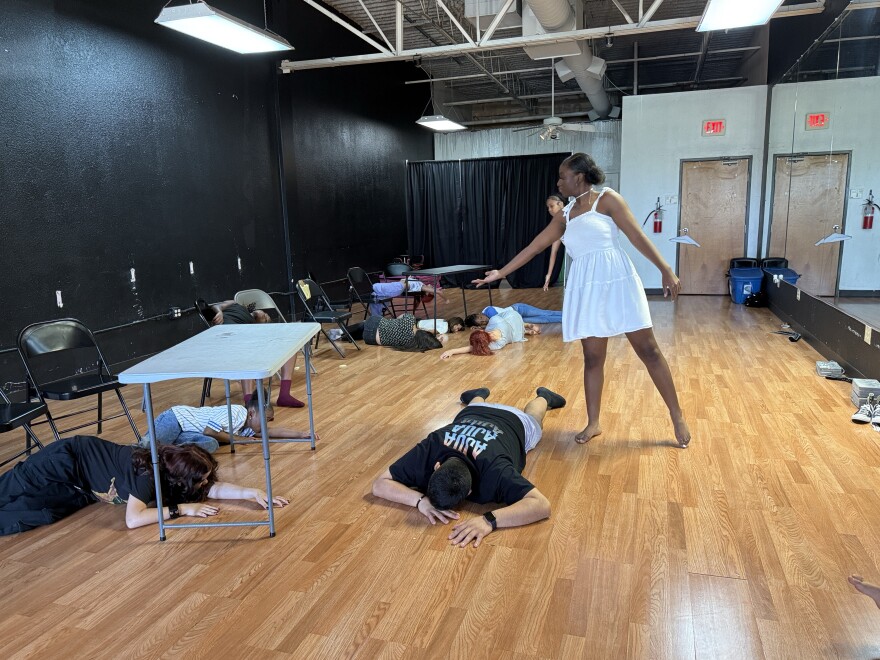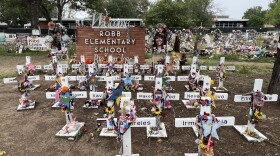That’s a bad idea, Favian Herrera Jr. thought when his wife, a teacher, suggested the Robb Elementary School shooting as the next subject in their dance series, “Echoes of Justice.”
Last year, the series launched with a work about the 1973 murder of 12-year-old Santos Rodriguez by a Dallas police officer, so it wasn't like they were allergic to controversial topics.
“I’m all about that. I wanted to tackle it,” Herrera says in a Zoom interview as the heavily researched piece is about to premiere. “It’s done with great sensitivity, great class, as much as we possibly could, staying true to the facts.”
But just because it’s fact-based doesn’t mean Herrera Dance Project’s Unanswered for 77: The Time Between is a literal interpretation of the shooting and the events that led up to and followed it.
As dancers, choreographers and educators, he and Madi Frampton-Herrera, who teaches math at Jesus Moroles Expressive Arts Vanguard elementary school in Dallas, have crafted a work that deals both directly and abstractly with what happened in Uvalde on May 24, 2022, when 18-year-old Salvador Ramos, a former Robb student, killed 19 children and two teachers in side-by-side classrooms.
Unanswered uses choreographed movement, police body-cam and news footage, video the Herreras took when they visited Uvalde and pop songs like Patsy Cline’s “Crazy,” Frank Sinatra’s “That’s Life” and Oasis’ “Wonderwall” to depict and reflect on the events of that day.
The cast includes children, including their two young daughters. Herrera plays Ramos and the husband of one of the murdered teachers, who died of a heart attack two days later. Unanswered imagines a dance duet for the couple.
The title of the work, which will run 77 minutes without an intermission, refers to the number of minutes that elapsed between Ramos entering the first classroom and law enforcement officers going in to try to stop him. As if the shooting wasn’t tragic enough, the failure of officers to act quickly tore the community further apart, leading to finger-pointing and official investigations.
The night before the first performance, Herrera Dance Project is holding a panel discussion that will include Arnie Reyes, a fourth-grade teacher who survived the shooting, and Javier Cazares, the father of Jacklyn Cazares, a 9-year old student who was shot and killed by Ramos. WFAA reporter Natalie Haddad, who covered the shooting, is moderating.

Herrera says Cazares called the Latino Cultural Center, where Unanswered will be performed July 30 and Aug. 1, when he heard about the show. He was upset that someone would create a piece about the tragedy. But after two hours on the phone, Herrera says, Cazares agreed to participate.
As with the dance work itself, they hope to spark dialogue about gun violence.
The interview with the Herreras has been edited for length and clarity.
Where did the idea come from to create a dance performance about a devastating school shooting?
Madi Frampton-Herrera: I noticed that all of the doors in my school have these wooden vents that can be kicked in. I'm the first door when you come into the building. I thought, “This is dangerous.” I started looking at ways you can protect your classroom. What’s the best line of defense? I came across Uvalde, where every single line of defense failed. It struck me that we need to have a conversation about it, and we don’t.
We talked to Natalie, and she said it’s like screaming into a void. When you bring up Uvalde, people don’t want to know anything more about it. But the sad part is, if we don't have the conversation, we're not going to make change. The beautiful part about dance is we're not verbally in your face. People can insinuate from the abstract without the gory details.
Favian Herrera Jr.: The first person I reached out to was the surviving teacher, Arnie Reyes. He gave us details of what it was like that day. Afterward, I decided we were going to Uvalde. We spent more time with him. We went to the grave sites. We walked around the school. We went where the shooter lived. We went where he went that day. We stood where he wrecked. We looked inside the cafeteria where they had their awards ceremony that last day, and we looked through the whole city at the memorials.
I have my perspective on where we're at with gun violence and legislation. But when you're creating something of this nature, it's not about your political opinion or your belief. It's about being able to tell the story for what it is and understanding what built this person. He just didn't wake up one day and decide to go kill children. This was something that was cultivated.
I want people to sit in the theater for 77 minutes. I want them to experience the amount of time that these folks suffered in this classroom. Some people have sent messages saying they're offended by it, that we shouldn't do this work, it's wrong. That's the kind of reception we want, because if something like dance offends you, then obviously there's a problem we need to address.
If we can create conversation, and we can try to lead towards a solution, we can give the people of Uvalde a voice. Let’s face it, they're in this small, rural town in Texas completely divided. Half of the people don't want to talk about it. The other half are in constant mourning.
You could re-traumatize people. Is what happened during those 77 minutes depicted? Tell me about the shape and content of the piece.
Madi: We have used news footage that’s very tasteful. We're not using any blood. Could it be upsetting? Absolutely. It’s an upsetting situation, and our audience should know going into this that it is an upsetting show. However, we do have moments of reprieve.
Favian: We don't want you to have PTSD. Dance allows you to be able to tackle it theatrically: desks, teacher, students, paper for kids to draw on. They're going to be engaged in activities that they would have been engaged in that day.
Madi: The heaviest part that may be upsetting is hallway footage of an officer standing outside the classroom. You can hear gunshots from inside the classroom. Arnie said it sounds like books falling.
What else do you depict?
Favian: The show opens with a dive deep into the internet with footage of the shooter being teased and bullied in school. I found footage of his profile on a gaming app. I found the text messages that he was sending to his grandmother that day. I found footage of him purchasing the weapons that he shot the children with.
I have a scene where Arnie tells a story about how the shooter would walk around him and taunt him, pour water on him and smear blood on his face from the floor. The children are lying on chairs, so you see their bodies.
What has been the reaction in Uvalde?
Madi: The community is so divided. When you go to Uvalde, you can feel it. The air is so thick. People feel either that the children who died need more compensation and attention, or children who survived do. I don't feel there is a right answer. They all have a right to their feelings.
Details
Panel discussion on July 29 at 7 p.m. at the Oak Cliff Cultural Center, 223 Jefferson Blvd., with performances on July 30 and Aug. 1 at Latino Cultural Center, 2600 Live Oak St. Free. herreradanceproject.com.
Arts Access is an arts journalism collaboration powered by The Dallas Morning News and KERA.
This community-funded journalism initiative is funded by the Better Together Fund, Carol & Don Glendenning, City of Dallas OAC, Communities Foundation of Texas, The University of Texas at Dallas, The Dallas Foundation, Eugene McDermott Foundation, James & Gayle Halperin Foundation, Jennifer & Peter Altabef and The Meadows Foundation. The News and KERA retain full editorial control of Arts Access’ journalism.





